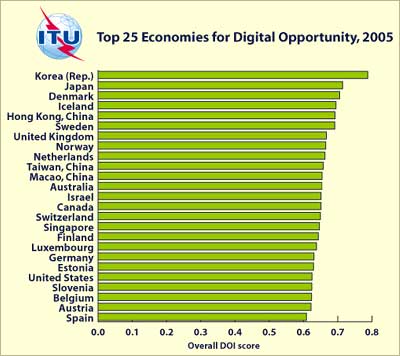|
|
| Help | |
| You are here: Rediff Home » India » Business » Special » Features |
|
| ||||||||||||||||||||||||||||||||||||||||||||
|
| ||||||||||||||||||||||||||||||||||||||||||||
There's no one close to South Korea in terms of 'digital opportunity,' according to the World Information Society Report published by the United Nations. South Korea ranks number 1 in the rankings thanks to the country-wide use of broadband Internet services.
India does not feature among the top 25 nations for digital opportunity; it ranks 119th on the index, owing to poor infrastructure and higher broadband costs.
But, the report says that India has made dramatic progress, doubling its digital opportunity from 2001 to 2005. Lower prices and liberalization have been the reasons cited for India's impressive improvement. However, it still ranks low on the overall index at 119, dragged down by poor infrastructure that threatens expansion of its successful business process outsourcing operations.
Major Gainers in Digital Opportunity Index
Economy | DOI 2005 | DOI 2001 | Change | Drivers |
1. India | 0.29 | 0.17 | 73% | O |
2. China | 0.42 | 0.29 | 46% | I |
3. Russia | 0.44 | 0.32 | 41% | I |
4. Hungary | 0.55 | 0.40 | 37% | I,U |
5. Peru | 0.38 | 0.28 | 37% | O,I,U |
6. Indonesia | 0.33 | 0.24 | 36% | O |
7. Brazil | 0.43 | 0.32 | 35% | O,I,U |
8. Poland | 0.52 | 0.39 | 34% | I,U |
9. Japan | 0.71 | 0.54 | 33% | U |
10. Venezuela | 0.43 | 0.32 | 33% | U |
11. Chile | 0.52 | 0.40 | 32% | U |
12. Egypt | 0.38 | 0.29 | 32% | I |
13. Korea | 0.78 | 0.60 | 31% | U,I |
14. Israel | 0.66 | 0.50 | 31% | U |
15. Spain | 0.61 | 0.47 | 28% | U |
Average | 0.50 | 0.37 | 37% | ---- |
40 economies | 0.54 | 0.43 | 27% | ---- |
In fact, India is the biggest gainer in digital opportunity index, followed by China, Russia, Hungary, Peru, Indonesia, Brazil, Poland, Japan and Venezuela (See table).
Lowest broadband prices
Economy | Company | Speed kbit/s | Price per mth(in US $) | US $ | Change |
1. Japan | Yahoo BB | 51'200 | 31.19 | 0.07 | -12.5% |
2. Korea | Hanaro | 51'200 | 40.59 | 0.08 | ---- |
3. Netherlands | Internet Access | 20'480 | 27.97 | 0.14 | -81.3% |
4. Taiwan | Chunghwa | 12'288 | 22.67 | 0.18 | ---- |
5. Sweden | Bredbandsbolaget | 24'576 | 56.08 | 0.23 | -6.5% |
6. Singapore | Starhub | 30'720 | 73.17 | 0.24 | -85% |
7. Italy | Libero | 12'288 | 37.23 | 0.30 | -73.8% |
8. Finland | Elisa | 24'576 | 85.64 | 0.36 | -51.4% |
9. France | Free | 10'240 | 37.29 | 0.36 | -90.1% |
10. United States | Comcast | 4'096 | 20.00 | 0.49 | ---- |
11. Germany | Freenet.cle | 6'016 | 30.95 | 0.52 | ---- |
12. United Kingdom | Pipex | 8'128 | 50.89 | 0.63 | -53.6% |
13. Hong Kong | Netvigator | 4'614 | 51.17 | 0.83 | ---- |
14. Portugal | Sapo | 8'128 | 75.82 | 0.93 | ---- |
15. Canada | Bell | 4'096 | 41.26 | 1.01 | -3.93% |
Average | 18'287 | 44.33 | 0.42 | -50.8% | |
Best Practice (Top 20%) | 40'960 | 27.59 | 0.08 | -73.3% | |
Source: ITU
The report also states that the country with the lowest broadband prices is Japan, followed by South Korea, Netherlands, Taiwan, Sweden, Singapore and Italy (See table).
These aim to narrow the digital divide between rich and poor countries and provide near-universal access to information and communications technologies (ICT).
 Japan, Denmark, Iceland, Hong Kong, Sweden, the United Kingdom, Norway, Netherlands and Taiwan make up the rest of the top 10 nations for digital opportunity (See image).
Japan, Denmark, Iceland, Hong Kong, Sweden, the United Kingdom, Norway, Netherlands and Taiwan make up the rest of the top 10 nations for digital opportunity (See image).
The United States, despite its technological prowess, ranks 21st.
The 'digital opportunity index', compiled by the International Telecommunication Union, measures progress made towards the goals set by the world summit on information society.
The Digital Opportunity Index is a composite index has been created from a set of eleven internationally-agreed core ICT indicators (established by the Partnership on Measurement of the Information Society).
The DOI has a flexible and versatile structure, based on three categories:
Opportunity measures the basic access and affordability needed to participate in the information society, in mobile population coverage, Internet access prices and mobile prices;
Infrastructure includes measures of different networks (fixed lines, mobile cellular subscribers and household Internet access) and devices (households with a computer and mobile Internet access devices).
Utilisation evaluates ICT usage in Internet users and broadband subscribers (fixed and mobile).
More Specials|
|
| © 2008 Rediff.com India Limited. All Rights Reserved. Disclaimer | Feedback |